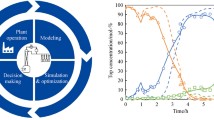Abstract
A large number of modelling tools exist for the construction and solution of mathematical models of chemical processes. Each (chemical) process modelling tool provides its own model representation and model definition functions as well as its own solution algorithms, which are used for performing computer-aided studies for the process under consideration. However, in order to support reusability of existing models and to allow for the combined use of different modelling tools for the study of complex processes, model integration is needed. This paper presents a concept for an integration platform that allows for the integration of modelling tools, combining their models to build up a process model and performing computer-aided studies based on this integrated process model. In order to illustrate the concept without getting into complicated algorithmic issues, we focus on steady-state simulation using models comprising only algebraic equations. The concept is realized in the component-based integration platform CHEOPS, which focuses on integrating and solving existing models rather than providing its own modelling capabilities.
Similar content being viewed by others
References
Aspentech (2000) PolymersPlus User Guide, release 10.2, Boston
Aspentech (2001) AspenPlus 11.1 User Guide. Boston
Bezzo F, Macchietto S, Pantelides CC (2000) A general framework for the integration of computational fluid dynamics and process simulation. Comput Chem Eng 24(2–7):653–658
Bosman G (2003) A survey of co-design ideas and methodologies. www.guusbosman.nl/downloads/surveycodesign.pdf
Braunschweig BL, Pantelides CC, Britt HI (2000) Process modelling, the promise of open software architectures. Chemical Engineering Progress, pp 65–76
Colan: CAPE-OPEN laboratories network. Information vailable online at http://www.colan.org
Cook WJ, Klatt J, Brosilow CB (1987) Simulation of large scale dynamic systems. I. Modular integration methods. Comput Chem Eng 11(3):241–253
Dias homepage. http://www.dis.anl.gov/DIAS/index.html
Famas homepage. http://www.famas.tudelft.nl/
Fluent product information. http://www.fluent.com/
Grisby D, Lo S-L (2001) OmniORB User’s Guide 3.0. http://www.omniorb.org
Guessoum Z, Nadjemi O, Braunschweig B, Roux P, Yang A, Fraga ES, Stalker D, Pinol ID, Serra M, Paen D (2003) Agent-based computer-aided process engineering. In: Braunschweig B, Alvarado M, Bañares-Alcantara R, Sheremetov L (eds) Proc. 2nd workshop on intelligent computing in the petroleum industry (ICPI 2003), Acapulco, Mexico, 9–15 August 2003, pp 68–73
Haase T (2003) Semi-automatic wrapper generation for a-po steriori integration. In: Proc. workshop on tool integration in system development, Helsinki, September 2003, pp 84–88. Workshop at ESCE/FSE 2003. 9th European software engineering conference and 11th ACM SIGSOFT symposium on the foundations of software engineering. http://www.es.tu-darmstadt.de/english/events/tis
Henning M, Vinoski S (1999) Advanced CORBA programming with C++. Addison-Wesley, Reading, MA
Holl P, Marquardt W, Gilles ED (1988) Diva – a powerful tool for dynamic process simulation. Comput Chem Eng 12:421–426
Huebert H (1998) A survey of hw/sw cosimulation technices and tools. M.S. thesis, Royal Institute of Technology, Sweden, June 1998
IK-CAPE Consortium (1998) Thermodynamik-Schnittstelle für CAPE-Anwendungen
Kulikov V, Briesen H, Grosch R, Yang A, von Wedel L, Marquardt W (2004) Modular dynamic simulation strategy for particulate process flowsheets by means of tool integration. Chem Eng Sci (submitted)
Lee EA (2001) Overview of the Ptolemy project. Technical Report UCB/ERL M01/11, University of California, Berkeley, CA
Marquardt W (1991) Dynamic process simulation – recent progress and future challenges. In: Arkun Y, Ray HW (eds) Chemical Process Control CPC-IV. CACHE Publications, Austin, TX, pp 131–180
Marquardt W, Nagl M (2003) Workflow and information centered support of design processes. In: Proc. 8th international symposium on process systems engineering (PSE 2003), Kunming, China. Comput Chem Eng (in press)
Marquardt W, von Wedel L, Bayer B (2000) Perspectives on lifecycle process modeling. In: Malone MF, Trainham JA, Carnahan B (eds) Foundations of computer-aided process design, AIChE symposium series 323, vol 96. AIChE, pp 192–214
Object Management Group (2002) The Common Object Request Broker: architecture and specification. Version 2.6.1, May 2002. http://www.omg.org
Pantelides CC, Barton PI (1993) Equation-oriented dynamic simulation current status and future perspectives. Comput Chem Eng 17(Suppl 1):263–285
Piela PC, Epperly TG, Westerberg KM, Westerberg AW (1991) Ascend: an object-oriented computer environment for modeling and analysis: the modeling language. Comput Chem Eng 15(1):53–72
Process Systems Enterprise (2002) gPROMS Introductory User Guide, Release 2.1.1
Python homepage. Available online at http://www.python.org/
Sahul ZH, Wang KC, Hsiau Z-K, McKenna EW, Dutton RW (1995) Heterogeneous process simulation tool integration. In: IEEE Transactions on Semiconductor Manufacturing, volume 9
Scharwächter H, Yang A, von Wedel L, Marquardt W (2002) A tool integration framework for dynamic simulation in process engineering. In: Proc. 15th IFAC world congress on automatic control, Barcelona, Spain, 21–26 July 2002
Schlüter M (2003) Konzepte und Werkzeuge zur rechnerunterstützten Auslegung von Aufbereitungsextrudern in übergreifenden Entwicklungsprozessen. Doctoral dissertation, RWTH Aachen, Germany
Schopfer G, Marquardt W (2004) A tool integration framework for general model-based applications. Technical Report LPT-2004, Lehrstuhl für Prozesstechnik, RWTH Aachen
Schopfer G, von Wedel L, Marquardt W (2000) An environment architecture to support modeling and simulation in the process design lifecycle. Technical Report LPT-2000-34, Lehrstuhl für Prozesstechnik, RWTH Aachen
von Wedel L, Marquardt W (2000) Cheops: a case study in component-based process simulation. In: Malone MF, Trainham JA, Carnahan B (eds) Foundations of Computer-Aided Process Design (FOCAPD ’99), AIChE Symposium Series, vol 323. AIChE, pp 494–497
Westerberg AW, Hutchinson HP, Motard RL, Winter P (1979) Process flowsheeting. Cambridge University Press, Cambridge, UK
Wulkow M, Gerstlauer A, Nieken U (2001) Modeling and simulation of crystallization processes using parsival. Chem Eng Sci 56(7):2575–2588
Author information
Authors and Affiliations
Corresponding author
Rights and permissions
About this article
Cite this article
Schopfer, G., Yang, A., von Wedel, L. et al. CHEOPS: A tool-integration platform for chemical process modelling and simulation. Int J Softw Tools Technol Transfer 6, 186–202 (2004). https://doi.org/10.1007/s10009-004-0157-6
Published:
Issue Date:
DOI: https://doi.org/10.1007/s10009-004-0157-6




